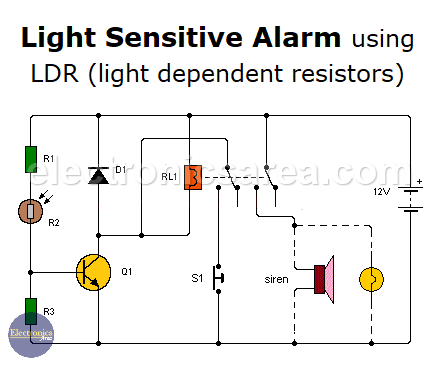Light sensitive alarm using a Light Dependent Resistor
This light sensitive alarm is very simple and works using, as main components, a transistor, an LDR and a relay. The alarm activates when the illumination level changes from almost total darkness to a moderately high illumination level.
When this happens, the alarm is locked and the alarm signal, be it a light or (light bulb or LED bulb) or sound (siren), remains active.
When the light enters the dark area, the LDR illuminates and its resistance decreases. If the resistance value of the LDR is less than 10 k ohms, the voltage at the transistor base Q1 rises, the base current increases, and the transistor goes into saturation and activates the relay. Most LDRs have a resistance less than 10K when illuminated.
Relay must be 12 V with two normally open contacts (NO). One contact to activate the siren or warning light and another to interlock the alarm.
In order to deactivate the relay, and to turn off the siren or visual warning, a normally closed (NC) switch (S1) is placed in series with the relay. Pressing the S1 switch opens the relay circuit, the relay is left without its ground connection, so it is de-energized.
Very important: If the LDR is still illuminated, the relay will remain active after releasing the switch.
LDR (Light Dependent Resistor)
Light sensitive alarm circuit list of components
- 1 NPN transistor, 2N3704 (Q1)
- 1 general purpose LDR (R2)
- 1 12V / 2 pole normally open (NO) relay (RL1)
- 1 560 ohms resistor (R1)
- 1 4.7 k resistor (R3)
- 1 semiconductor diode 1N4001 (D1)
- 1 normally closed (NC) switch (S1)
- 1 12v Light bulb, Siren or both (optional)


